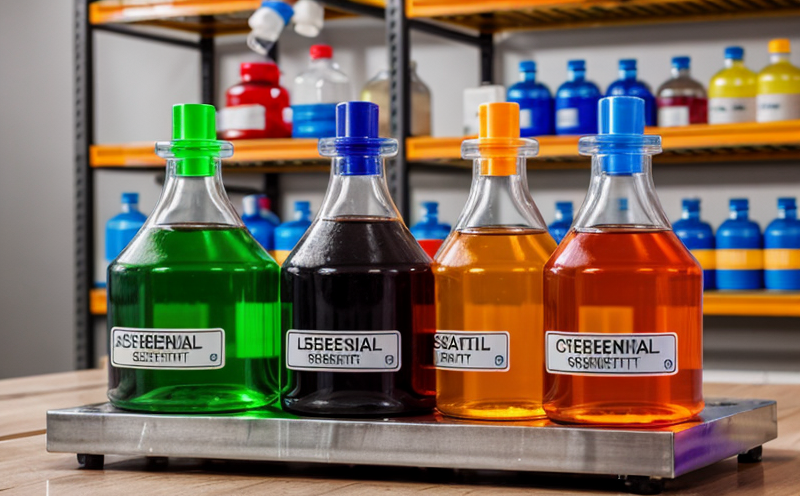Textile Dye Safety Testing for Restricted Amines
The textile industry is a global powerhouse with an annual market value exceeding $1 trillion. Textiles and clothing are essential to our daily lives, yet they must meet stringent safety standards to protect human health and the environment. One critical aspect of this safety is ensuring that dyes used in textiles do not contain harmful restricted amines. Restricted amines can pose significant risks if they migrate from fabrics into skin or other surfaces, leading to potential allergenic reactions or even more severe health hazards.
In compliance with international standards such as ISO 17073:2016 and ASTM D6892-15, our laboratory offers comprehensive textile dye safety testing for restricted amines. This service ensures that textiles are safe from harmful components during manufacturing, processing, and use. The process involves several key steps:
- Sample Preparation: Textile samples undergo thorough preparation to ensure accurate analysis.
- Liquid Chromatography-Mass Spectrometry (LC-MS): This advanced analytical technique identifies and quantifies restricted amines present in the dye. LC-MS provides high sensitivity, ensuring that even trace amounts of harmful substances are detected.
- Data Analysis: Our experts analyze the data to determine compliance with relevant regulations.
- Reporting: Detailed reports are provided highlighting any restricted amines found and their concentration levels. This information is crucial for quality control and product safety.
The importance of this testing cannot be overstated. In recent years, several high-profile recalls have been due to unsafe textile dyes containing harmful restricted amines. By ensuring compliance through rigorous testing, manufacturers can protect both consumers and the environment from potential health risks associated with these substances.
| Restricted Amines | Health Risks |
|---|---|
| Nitrosamines | Carcinogenic; linked to cancer |
| Aromatic amines | Can be skin irritants and sensitizers |
| Heterocyclic amines | Potential carcinogens |
| Foaming agents (e.g., methylene diphenyl diisocyanate) | Toxic; can cause respiratory issues |
Our laboratory adheres strictly to international standards, ensuring that all tests are conducted with the highest level of accuracy and precision. This commitment is reflected in our state-of-the-art instrumentation and highly skilled technical staff.
In conclusion, textile dye safety testing for restricted amines is an essential component of any responsible manufacturer’s quality control process. By investing in this service, companies can safeguard their reputation, comply with regulatory requirements, and provide safe products to the market.
Why It Matters
The importance of testing textile dyes for restricted amines cannot be overstated due to potential health hazards. Restricted amines are known carcinogens that can cause severe allergic reactions if they migrate from fabrics into skin or other surfaces. These substances have been linked to various adverse effects, including cancer and respiratory issues.
Consumer safety is paramount in the textile industry, and compliance with international standards such as ISO 17073:2016 and ASTM D6892-15 ensures that products meet strict safety requirements. These regulations are designed to protect consumers from potential health risks associated with harmful restricted amines.
Non-compliance can lead to significant legal consequences, including product recalls and reputational damage. For companies involved in the textile sector, adherence to these standards is not just a legal requirement but also a commitment to consumer safety and well-being.
The global market for textiles and clothing is vast and diverse, with products ranging from everyday wear to specialized industrial fabrics. By ensuring that all textile dyes meet strict safety criteria, manufacturers can protect their brands and maintain trust with consumers.
Industry Applications
| Industry Segment | Application |
|---|---|
| Fashion & Apparel | Ensuring that textiles used in clothing are free from harmful restricted amines. |
| Homes & Textile Products | Testing materials like carpets, curtains, and upholstery to ensure they do not contain harmful substances. |
| Rug Manufacturing | Verifying that the dyes used in rugs are safe for both production and end-use environments. |
| Baby & Children’s Apparel | Guaranteeing that textiles intended for use by infants and children do not contain harmful restricted amines. |
Our laboratory’s expertise in textile dye safety testing is applicable across various sectors, ensuring that manufacturers can meet strict regulatory requirements and provide safe products to consumers. We work closely with clients from the fashion industry, home textiles sector, rug manufacturing companies, and those producing garments for infants and children.
The demand for safer textiles has increased globally due to heightened consumer awareness of product safety. By choosing our laboratory’s textile dye safety testing service, manufacturers can stay ahead of regulatory changes and ensure that their products meet the highest standards of safety and quality.
Environmental and Sustainability Contributions
The environmental impact of textiles is a growing concern, with the industry contributing significantly to global pollution. By conducting thorough textile dye safety testing for restricted amines, our laboratory plays a crucial role in promoting sustainable practices within the sector.
Testing ensures that dyes used in textile production do not contain harmful substances that could leach into water supplies or contribute to air and soil contamination. This commitment to sustainability extends beyond just the manufacturing process, as safer textiles lead to healthier environments for all stakeholders involved.
Our laboratory’s expertise in this area aligns with broader industry initiatives aimed at reducing environmental impact. By promoting the use of safe dyes, we support a circular economy where resources are used efficiently and waste is minimized. This approach not only benefits manufacturers but also contributes positively to global sustainability efforts.
Moreover, compliance with international standards ensures that companies adhere to best practices in terms of resource management and waste reduction. By choosing our laboratory’s textile dye safety testing service, clients can contribute meaningfully to environmental conservation while maintaining product quality and consumer trust.





